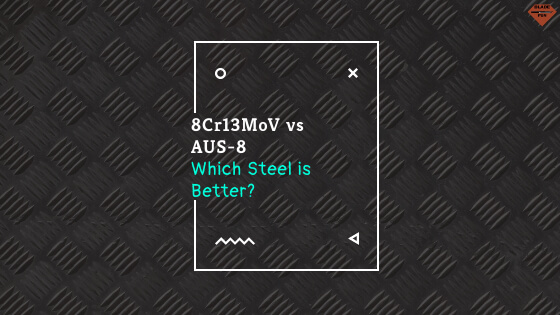8Cr13MoV and AUS-8 are both great steels for the price. They’re both really affordable knife steels that you’ll be able to use and abuse without much guilt. But, of course, we want to know which one is better.
So, here’s the short version:
8Cr13MoV and AUS-8 are going to perform almost identically. The minor differences between the two will be in the corrosion resistance and toughness category: AUS-8 wins out slightly in both. However, you’re unlikely to notice much of a difference, so choose whichever one you like more.
Of course, if you’d like to become more of a blade steel expert, then we’re going to have to go deeper than that.
AUS-8
AUS-8 is usually made up of about .75% carbon, 14% chromium, 0.3% molybdenum, and about 0.25% vanadium. These are all going to be generalities, though. The exact amounts will vary between batches of steel (and thus knives).
All those components each do different things: The carbon increases strength (it’s important to note that at high levels, carbon leads to brittleness, which means easy chipping and breaking), the chromium increases corrosion resistance, the molybdenum increases hardenability (which basically means that it’s easier to harden, and thus manufacture), and vanadium improves wear resistance and strength.
Because of the chromium content, AUS-8 is considered a stainless steel, meaning it will be more rust resistant than knives that don’t have the stainless steel label.
AUS-8 vs AUS-8A
Occasionally, you’ll see the steel “AUS-8A” rather than “AUS-8.” The difference between the two is in how they are dealt with after their heat treatments.
AUS-8 is treated cryogenically, which leads to better edge retention. Unfortunately, it also means that it’s going to be more prone to microchipping, which can lead to bigger chips in the blade when you put it through more strenuous activities.
AUS-8A, on the other hand, is put through the process of annealing, which leads to increased toughness. It means that AUS-8A won’t chip as easily–instead, it’ll be more likely to roll. So, AUS-8A will be better for a beater knife compared to AUS-8.
8Cr13MoV
8Cr13MoV is pretty similar to AUS-8. It has almost the same composition and about the same performance.
The seemingly cryptic name of the steel actually refers to its composition. The 8 refers to the percentage of carbon (0.8%), the Cr13 refers to the percentage of chromium (about 13%), the Mo refers to molybdenum (of which it has about 0.3%), and the V refers to vanadium (of which it has about 0.25%).
Compared to AUS-8, 8Cr13MoV is going to be a little bit harder (and thus can get a finer edge), but won’t have the same amount of corrosion resistance. These differences are negligible, though: You’re not going to notice the difference.
8Cr13MoV vs 8Cr14MoV
8Cr13MoV is part of a line of similarly named steels–8Cr14MoV also being among them. If you ever see these, they all follow a similar pattern: The first number (8, in this case) refers to the carbon amount (about 0.8%) and the second number (13 and 14, respectively, in this case) refers to the amount of chromium (13% and 14%, respectively).
If you’d like to read more on the differences between these types of steels, we’ve got a whole article on it. You can check it out here.
The Main Differences
Basically, 8Cr13MoV and AUS-8 are going to perform nearly identically. AUS-8 will slightly win out in the toughness and corrosion resistance categories, but 8Cr13MoV will be able to get a finer edge. Ultimately, you’re not likely to notice much of a difference unless you’re super steel savvy, so just pick whichever one you like more.
Recommended Knives
If you’re looking for some knives with these types of steels, here are our favorites for each of these steels. (Just make sure to check with your local laws to ensure they’re legal in your area before buying anything.)
Kershaw Brawler – 8Cr13MoV
The Kershaw Brawler is a snappy black folding knife with a tanto blade and the SpeedSafe assisted opening system and a flipper. It’s got 8Cr13MoV steel and glass-filled nylon handles with a 4-position pocket clip. Overall, if you’re looking for a snappy assisted opening knife, you’ll enjoy this one.
Kershaw Shuffle II – 8Cr13MoV
If you want a knife in 8Cr13MoV that doesn’t have assisted opening, then that’s where the Shuffle II comes in. It’s a small, lightweight multi-function knife that comes in multiple colors. It’s got a thumb stud (manual) opening, a bottle opener, a pry bar, and a flat-head screwdriver.
If you’re looking for something a little more low-profile (and multi-faceted), you’ll be better off with the Shuffle II than with the Brawler.
Ontario Rat I – AUS-8
The Ontario Rat I is a knife that’ll withstand some punishment. It’s a manual opening knife with thumb studs, AUS-8 steel, a 4-position pocket clip, and nylon handles. There are a couple different versions of the Rat I that can come with different knife steels, but the one linked has AUS-8 steel.
It’s not as flashy as the Kershaw Brawler and it doesn’t have as many functions as the Shuffle II, but it’s a nice, solid, reliable knife that won’t draw too much attention. If that’s what you’re looking for, you’ll enjoy the Rat I.
Now that you’ve improved your knowledge on 8Cr13MoV and AUS-8, if you’re ready to go further into learning about knife steels (and knives in general), we’ve got a ton of articles for you. You can check them out here if you want.

